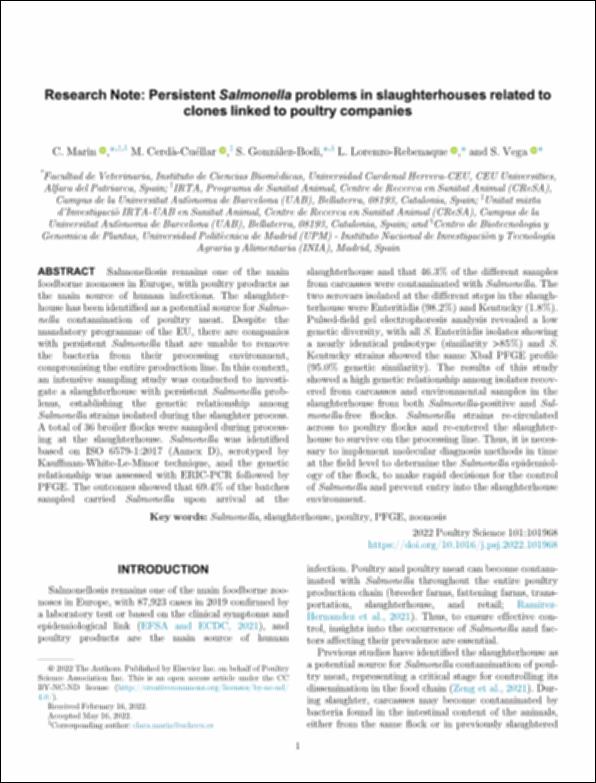Please use this identifier to cite or link to this item:
http://hdl.handle.net/10637/14256Research note : persistent "Salmonella" problems in slaughterhouses related to clones linked to poultry companies
| Title: | Research note : persistent "Salmonella" problems in slaughterhouses related to clones linked to poultry companies |
| Other Titles: | Persistent "Salmonella" problems in slaughterhouses related to clones linked to poultry companies |
| Authors : | Marín Orenga, Clara Cerdà Cuéllar, Marta González Bodí, Sara Lorenzo Rebenaque, Laura Vega García, Santiago |
| Keywords: | Zoonosis.; Poultry - Quality control.; Salmonelosis en los animales.; Zoonoses.; Slaughtering and slaughter-houses - Quality control.; Carne de ave - Control de calidad.; Salmonellosis in animals.; Mataderos - Control de calidad. |
| Publisher: | Elsevier |
| Citation: | Marin, C., Cerdà-Cuéllar, M., González-Bodi, S., Lorenzo-Rebenaque, L. & Vega, S. (2022). Research note : persistent "Salmonella" problems in slaughterhouses related to clones linked to poultry companies. Poultry Science, vol. 101, i. 8 (aug.), art. 101968. DOI: https://doi.org/10.1016/j.psj.2022.101968 |
| Abstract: | Salmonellosis remains one of the main foodborne zoonoses in Europe, with poultry products as the main source of human infections. The slaughterhouse has been identified as a potential source for Salmonella contamination of poultry meat. Despite the mandatory programme of the EU, there are companies with persistent Salmonella that are unable to remove the bacteria from their processing environment, compromising the entire production line. In this context, an intensive sampling study was conducted to investigate a slaughterhouse with persistent Salmonella problems, establishing the genetic relationship among Salmonella strains isolated during the slaughter process. A total of 36 broiler flocks were sampled during processing at the slaughterhouse. Salmonella was identified based on ISO 6579-1:2017 (Annex D), serotyped by Kauffman-White-Le-Minor technique, and the genetic relationship was assessed with ERIC-PCR followed by PFGE. The outcomes showed that 69.4% of the batches sampled carried Salmonella upon arrival at the slaughterhouse and that 46.3% of the different samples from carcasses were contaminated with Salmonella. The two serovars isolated at the different steps in the slaughterhouse were Enteritidis (98.2%) and Kentucky (1.8%). Pulsed-field gel electrophoresis analysis revealed a low genetic diversity, with all S. Enteritidis isolates showing a nearly identical pulsotype (similarity >85%) and S. Kentucky strains showed the same XbaI PFGE profile (95.0% genetic similarity). The results of this study showed a high genetic relationship among isolates recovered from carcasses and environmental samples in the slaughterhouse from both Salmonella-positive and Salmonella- free flocks. Salmonella strains re-circulated across to poultry flocks and re-entered the slaughterhouse to survive on the processing line. Thus, it is necessary to implement molecular diagnosis methods in time at the field level to determine the Salmonella epidemiology of the flock, to make rapid decisions for the control of Salmonella and prevent entry into the slaughterhouse environment. |
| Description: | Este artículo se encuentra disponible en la siguiente URL: https://www.sciencedirect.com/science/article/pii/S0032579122002607 |
| URI: | http://hdl.handle.net/10637/14256 |
| Rights : | http://creativecommons.org/licenses/by-nc-nd/4.0/deed.es |
| ISSN: | 0032-5791 1525-3171 (Electrónico) |
| Language: | es |
| Issue Date: | 11-Aug-2022 |
| Center : | Universidad Cardenal Herrera-CEU |
| Appears in Collections: | Dpto. Producción y Sanidad Animal, Salud Pública Veterinaria y Ciencia y Tecnología de los Alimentos |
Items in DSpace are protected by copyright, with all rights reserved, unless otherwise indicated.


